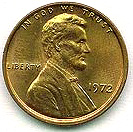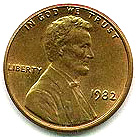CATALYTIC REACTIONS?
If you have a photo or other
graphic that reflects an aspect of life
(including laboratory life) or a
quotation that scientists might
appreciate that would be fit to print
in the space to the right, why not
send it to us via e-mail:
<catalyst@nih.gov>; fax: 402-4303; or mail: Building 2, Room 2E26.
Also, we
welcome letters to the editor for publication and your reactions to anything
on the Catalyst pages.
In Future Issues...
Informationists at the NIH Library
Research Festival 2005
Ever in Training: GPP, HHMI, OIR
 |
 |
Kids' Catalyst
Eureka! Part 2: A Penny for Your Thoughts
Last issue we learned about Archimedes’ problem-solving powers—how he discovered that Greek King Heiro was cheated and how water displacement led him there. He was dealing with a gold crown that might have contained less gold than it was supposed to contain.
We here in the United States today can use pennies—which are not quite what they used to be—to tackle the same kind of problem. (For our international readers, you may be surprised to find that your coinage has undergone similar changes, and you can apply the same experiment to the coins of your realm!)
In 1982, the U.S. Mint made a big change in our coin of lowest value: The main ingredient of our pennies changed from copper to zinc (zinc pennies cost less to make). But the two kinds of pennies look the same—the zinc-based penny has a copper-plated coating—and if you drop ten zinc pennies into a full glass of water, they will displace the same amount of water as would 10 copper pennies (same volume).
So how can you tell the difference? Weight.
If you have a scale that can measure tenths of a gram, great, but you may want to try making your own home scale. There are many ways to do this, but here’s a start:
Tie a piece of string around the middle of a ruler and hold up the string so the ruler hangs in the air. Adjust the string until it balances perfectly (be patient—this is much harder than it sounds). For greater stability than your arm may be able to muster and for a better receptacle for the objects you are weighing, straighten out the hook of a wire hanger, and attach a string to where the metal twists; tie the end of the string around a doorknob. Attach a paper cup to each end of the hanger, and there’s your scale!
Perhaps the hardest part of your experiment will be finding pennies minted before 1982 (here’s where an old penny jar comes in handy, but there are still plenty of these pennies in circulation).
Once you’ve got your two sets of pennies, place the 10 copper pennies and the 10 zinc pennies into their opposing cups—and voila! The heavier side will bow down. Same volume, different weight. (You will see that the coin that costs more to make is also the heavier coin.)
See how Archimedes figured it out? The fake crown weighed the same as the gold, but displaced a different amount of water. The pennies displace the same amount of water, but don't weigh the same. Caveat emptor!
|
PUBLISHER EDITORS SCIENTIFIC
EDITOR |
MANAGING
EDITOR COPY
EDITOR CONTRIBUTING
WRITERS |
EDITORIAL ADVISORY BOARD Jorge
Carrasquillo, CC
|